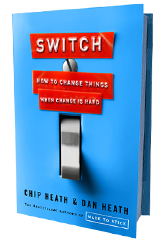
Last year, I resolved to keep track of every book I read in 2010, and I mostly did so. Here is my list of books I read in 2010, up to about November 15. That was when I came down with an awful case of bronchitis, which depleted my energy significantly for about 3 weeks. My books-per-week rate skyrocketed as I lay in bed, while my hours-updating-websites plummeted. I’ll catch up with November and December soon.
One of the first books I read in 2010 was Chip and Dan Heath’s Switch: How to Change Things When Change Is Hard. (Here’s my review of it.) Right before New Year’s, the Heath Brothers sent out an email with Five Tips for (Finally) Getting Your New Year’s Resolution Right, based on the research they conducted for Switch. The basic idea of Switch is this: you can’t rely on sheer willpower for change. Instead, you have to use other strategies, like harnessing your emotions, identifying “bright spots” that already work, and setting achievable goals. For example, their first tip:
1. Don’t be ambitious. When change is hard, aim low. A friend of ours, the editor of a wellness magazine, has a “1-Song Workout” that she does on days when she doesn’t feel like working out. She tells herself, “All I have to do is work out for one song,” but of course she often gets in a groove and finishes a full workout. So don’t set an ambitious New Year’s resolution like “I’ll work out four times a week.” Instead, plan to do “1-Song Workouts” on Monday and Thursday. Leave yourself room to overachieve — that feeling of “nailing it” is what will keep you hooked.
In keeping with this suggestion, I made only one New Year’s resolution this year: go outside every day for at least 10 minutes. Over the past year, I’ve noticed that my mood suffers when I’m inside for too long —and, since I work from home, mostly sit in front of a computer all day, and often spend my leisure time reading or watching movies, I’m inside a lot.
Of course, you might be too busy this time of year to think about significant changes in your life, and that’s OK. David Seah, a communication designer who is probably best know for his Printable CEO series of productivity tools, decided several years ago that New Year’s Day was a horrible time to be making resolutions. Instead, he uses Groundhog Day (February 2) for his annual resolutions, which are really his personal and business goals for the year. Why Groundhog Day? Tt’s a month after the holidays, and the whole idea of Groundhog Day is anticipating the future. Then, he reviews his progress each month —on March 3 (3/3), April 4 (4/4), May 5 (5/5), and so on. It’s a great idea, though not one that I’ve tried yet.
Did you make any New Year’s resolutions? Do you have some other time of the year when you set goals? Do you have any methods you use to stick to your plans or review your progress?
The former Associate Director for the Emerging Scholars Network, Micheal lives in Cincinnati with his wife and three children and works as a web manager for a national storage and organization company. He writes about work, vocation, and finding meaning in what you do at No Small Actors.

I made several of these, some of which I’ve recently shared at my blog: http://michaelwaustin.blogspot.com/2011/01/value-of-new-years-resolutions.html
I find doing so helpful, though my success in reaching these goals varies from year to year.